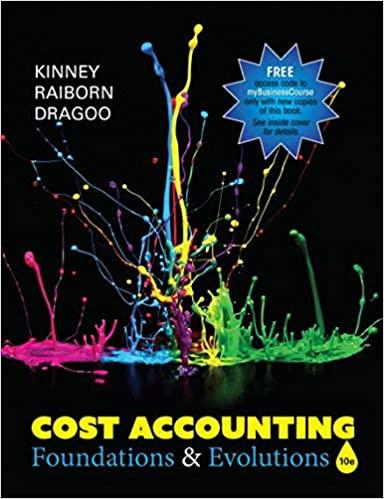Norton Weymer & Collins, LLP, a local accounting firm, has a formal budgeting system. The firm has
Question:
Norton Weymer & Collins, LLP, a local accounting firm, has a formal budgeting system. The firm has five partners, two managers, four seniors, two secretaries, and two bookkeepers. The budgeting process has a bottom-line focus; that is, the budget and planning process continues to iterate and evolve until an acceptable budgeted net income is obtained. The determination of an acceptable level of net income is based on two factors: (1) the amount of salary the partners could generate if they were employed elsewhere and (2) a reasonable return on the partners’ investment in the firm’s net assets.
For 2011, after careful consideration of alternative employment opportunities, the partners agreed that the best alternative employment would generate the following salaries:
Partner 1 ........$150,000
Partner 2 ........ 225,000
Partner 3 ......... 110,000
Partner 4 ......... 90,000
Partner 5 ......... 125,000
Total ..........$700,000
The second input to determining the desired net income level is more complex. This part of the desired net income is based on the value of the net assets owned by the accounting firm. The partners have identified two major categories of assets: tangible and intangible. The partners have agreed that the net tangible assets are worth $230,000. The intangible assets, consisting mostly of the accounting practice itself, are worth 1.1 times gross fees billed in 2010, which totaled $1,615,000. The partners have also agreed that a reasonable rate of return on the net assets of the accounting firm is 12 percent. Thus, the partners’ desired net income from return on investment is as follows:
Tangible assets .................... $230,000
intangible assets ($1,615,000 × 110 percent) ......... 1,776,500
Total investment ....................$2,006,500
Rate of return.................... × 0.12
Required dollar return .................. $240,780
The experience of the accounting firm indicates that other operating costs are incurred as follows:
Fixed expenses (per year)
Salaries (other than partners) .................$300,000
Overhead ........................ 125,000
Variable expenses
Overhead ...............15 percent of gross billings
Client service .............. 5 percent of gross billings
Source: Adapted from Jerry S. Huss, “Better Budgeting for CPA Firms,” Journal of Accountancy (November 1977), pp. 65–72. Reprinted with permission from the Journal of Accountancy. Copyright © 2000 by American Institute of CPAs. Opinions of the authors are their own and do not necessarily reflect policies of the AICPA.
a. Determine the minimum level of gross billings that would allow the partners to realize their net income objective. Prepare a budget of costs and revenues at that level.
b. If the partners believe that the level of billings you have projected in part (a) is not feasible given the time constraints at the partner, manager, and senior levels, what changes can they make to the budget to preserve the desired level of net income?
An intangible asset is a resource controlled by an entity without physical substance. Unlike other assets, an intangible asset has no physical existence and you cannot touch it.Types of Intangible Assets and ExamplesSome examples are patented...
Step by Step Answer:

Cost Accounting Foundations And Evolutions
ISBN: 9781618533531
10th Edition
Authors: Amie Dragoo, Michael Kinney, Cecily Raiborn





